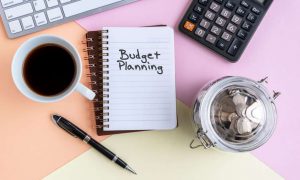Even people who closely track their spending might go over budget now and then. It happens, but going over budget isn’t the main issue—it’s how someone handles getting back on track that’s important.
There are a few steps consumers can take to get their budgeting back on track, though, and combining strategies might help speed up the budget repair process.
1. Keep an Eye on Spending
Reviewing account balances and statements once a week is an easy way to keep track of money coming in and money going out. A few big purchases can easily upset an otherwise balanced budget.
Waiting until the end of the month to check in on accounts leaves consumers at risk for excess spending and potentially overdrawing a checking account or having a higher credit card bill than they anticipated.
Checking in once a week leaves time to self correct and adjust the budget to help balance the numbers.
2. Identify What Went Wrong
Going over budget sometimes means there is uncertainty about where the money went. Overspending can mount quickly, putting the budget out of balance. It might only take a few extra additions to the grocery cart, an unexpected car repair, or a couple of splurge purchases.
When there is general overspending or if it’s just in a specific budgeting category, looking at recent bills and credit card statements might help identify where the money was spent. Were there too many restaurant meals, increasing food spending as a result? Was there too much temptation to shop online sales? Identifying budget lapses can make it easier to avoid them in the future.
3. Cut Unnecessary Expenses Temporarily
When a budget is too restrictive, it can feel punishing. A budget can account for the unnecessary spending that makes life fun like travel, dining out, shopping, gifts, beauty treatments, or other niceties.
If these expenses create a problem in the budget, those budget categories can be cut back on until it’s back on track. Once the budget is balanced again, those expenses can be put back into the budget. Balance is key.
4. Use a Budgeting Tool
Thanks to technology, there are high-tech budgeting tools available that make it possible to set spending goals in specific categories, such as travel, food, home maintenance and others, and make it easy to track spending in these categories throughout the month.
Some budgeting tools send alerts when overspending begins to happen or is about to happen and they can provide data and analysis that make creating a realistic budget possible.
Of course, there is nothing wrong with tracking income and spending habits on paper if that’s someone’s preference.
5. Build an Emergency Fund
One thing consumers can do to get back on track after going over budget is making sure they have an emergency fund for financially difficult times. An emergency fund is ideally set aside for future emergencies such as expensive medical bills or home repairs.
Emergency funds can also be used to prevent something from becoming an emergency. For instance, it can provide extra support if a debt payment is at risk of being paid late, which could incur fees and interest, and add to the debt load.
6. Explore Different Budgeting Techniques
Sometimes the trick to sticking to a personal budget—or bouncing back after going over that budget—is to try a different budgeting method. Not all budgeting methods will work for all personality types. Take some time to find the right budgeting fit, even if the first few rounds don’t go according to plan. There are a few different popular budgeting methods that might help someone get their budget back on track, such as:
1. Line-item budget
This is probably what most people think of when they think of a budget. The income and expenses are usually in a spreadsheet format where each expense is listed by category with the goal being not to exceed spending targets in any of the categories.
2. Proportional budget
This type of budgeting system requires dividing monthly income into three categories—needs, wants, and savings—based on percentages. The budgeter will allocate a spending percentage to each category and aim to stick to that budget. A common allocation is 50% to needs, 30% to wants, and 20% to savings.
3. Paying yourself first budget
For those who want to keep their budget simple, the paying yourself first method is pretty straightforward. The consumer simply “pays themselves first” which means they put money towards savings or financial goals first (perhaps 25% of take-home income) and then are left with the rest of their income to spend exactly as they need or wish to.
4. Envelope budget
This old-school budgeting method provides a hands-on approach to spending that can be helpful for people who tend to swipe their credit card without fully realizing the potential consequences. With this method, envelopes hold cash that represent different spending categories.
The budgeter then makes all their purchases for the month in cash. If an envelope runs out of cash, spending in that category stops until the next month or money is borrowed from another envelope, limiting spending in that category.
5. Zero-sum budgeting
With zero-sum budgeting, the consumer spends every dollar that they have. By “spending,” this budget refers to allocating every dollar that comes in towards a specific purpose (adding money to savings accounts counts as spending). Once a job is chosen for every dollar, there are zero leftover dollars, hence the name zero-sum budgeting.
Cut Out Temptations
Temptations happen, and it’s generally better to learn from budget mishaps than agonize over them. However, if there is a certain temptation that seems to rear its ugly head again and again while wreaking havoc with the budget, it might be time to send that temptation packing.
Common Triggers of Overspending
There are many things that might trigger overspending, but some common ones to look out for might be:
- Email sale and coupon promotions.
- Social media advertisements.
- Friends who pressure others to spend.
- Grocery shopping when hungry.
- Shopping when emotional.
- Shopping as a reward.
Launch a Side Hustle
For someone who wants to get their budget back on track, a side hustle can be one way to bring in more cash and maybe even build valuable career skills and opportunities. Launching a side hustle may help bring in extra income, but might also allow someone to pursue a passion outside of their day job.
The post How to get back on track after going over budget appeared first on Mediafeed.org
Original source: Mediafeed.org






